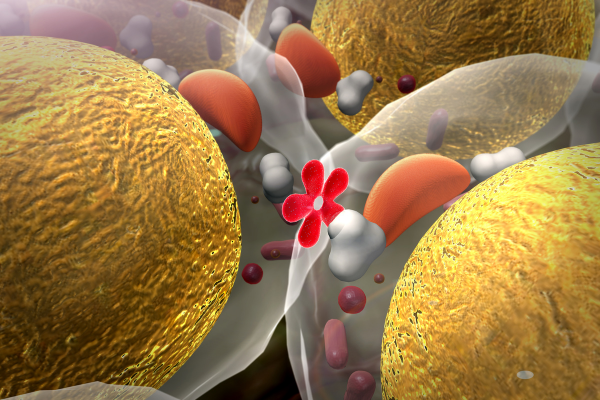Globally, the rate of obesity is continuously rising. Many in the fields of medicine and exercise physiology continue to believe that obesity is exclusively caused by a bad diet and insufficient exercise; however, plenty of evidence points to the possibility of chemical “obesogens,” which modify human metabolism and make people more susceptible to weight gain. It is a more important contributor to obesity than poor diet and reduced exercise.
Certain obesogens can permanently change the composition of fat cells in people’s bodies and change their metabolism during foetal and early life stages. Adult exposures have been related to additional obesogenic consequences. Many everyday products, such as personal hygiene items, cosmetics, cleaning supplies, toys, kitchenware, plastic drapes and tablecloths, furniture, beds, and clothing, now include obesogens.
What are obesogens?
Obesogens are substances that may interfere with the body’s regular metabolic processes, disrupt the endocrine system, and ultimately lead to obesity. These compounds can be found in many common products, including food additives, plastics, and pesticides.
Obesogens have an impact on:
- Disrupting the hormonal balance
- Fat accumulation
- Appetite regulation
They act directly on cells to increase or differentiate the adipocytes from stem cells by:
- Altering the adipocytes
- By increasing the accumulation of triglycerides
- Altering the rate of formation of new or destruction of the cells.
Additionally, obesogens indirectly influence the basal metabolic rate by altering the energy balance, favouring increased calorie storage.
This alteration occurs through changes in food intake and metabolism in various body components, including:
- Brain
- Pancreas
- Adipose tissue
- Liver
- Gastrointestinal tract
- Muscles
Long-term exposure to obesogens can have lasting effects on an individual’s life or increase the likelihood of developing obesity later in life. Research suggests that the impact of obesogens on long-term health is particularly significant during critical developmental stages.
The “developmental obesogen” theory is gaining support, proposing that certain substances can interfere with early-life developmental processes associated with metabolic homeostasis. Exposure to obesogenic substances in utero and early life can alter the metabolism, this alters the set point for weight gain. Altered gene expression in the adipose tissue, brain, gastrointestinal tract, liver and pancreas causes increased weight gain.
The term “obesogens” was defined more broadly by the Parma consensus in 2015 to encompass endocrine-disrupting substances that impact insulin resistance, hypertension, dyslipidemia, and hyperglycemia, among other obesity-related metabolic disorders that support metabolic syndrome. This category of compounds that alter hormones was identified as substances that disrupt metabolism.
Obesogen contribution to obesity
Obesity is influenced by a combination of genetic, epigenetic, and environmental factors, with the environmental component. Environmental chemicals influence the brain by altering the appetite and satiety centres as well as impacting the number, size, and function of fat cells.
Obesogenic substances have an impact on important physiological aspects such as muscle function, the gastrointestinal tract, the pancreas, and the liver. These substances have distinct effects in males and females.
To understand the environmental aspects of obesity, it is important to study the factors like:
- Nutrition
- Physical activity
- Stress
- Infections
- Microbiome
Obesogens have transgenerational effects, that is endocrine-disruptors (EDCs) operate by modifying genes during both exposure and development. The results of exposure to obesogenic substances carry on across the next generations with experiencing the effects despite not having direct exposure. Therefore a multigenerational approach is necessary for accurate assessment and understanding of their role in the development and persistence of obesity.
Mechanism of obesogen role in obesity
During the developmental stage and through the lifespan, obesogens can act by altering the concentration or timing of hormones and the concentration of ROS which results in altered gene expression. Increased insulin secretion, adipocyte differentiation, increased serum lipids, inflammation and function, altered adipocyte size number, non-alcoholic fatty liver disease, altered microbiome, insulin and leptin resistance, altered resting metabolic rate, increased food intake, and reduced voluntary energy expenditure are some of the altered hormone signalling and increased ROS by obesogens which results in metabolic changes noted in obesity.
Humans may be predisposed to accumulate more fat because they were exposed to obesogenic substances throughout critical developmental stages, making it difficult for them to maintain a healthy weight for the rest of their lives.
Impact of obesogens on human health
- The timing of exposure – The most critical period of vulnerability is during the in-utero phase, yet a comprehensive understanding of how obesogens influence this period requires further investigation. There is a possibility that the window of sensitivity for inducing disease outcomes extends beyond the evaluated exposure period. To unravel this, multiple exposure assessments spanning preconception, early pregnancy, and early infancy are essential.
- Lifelong prospective strategy – Recognising that certain effects may stem from functional changes, potentially of epigenetic origin, emphasises the need for a lifelong prospective approach. This approach should incorporate sensitive and precise endpoints that might only become apparent later in life.
- Varied and minimal exposure – Exposure to obesogens and endocrine-disrupting chemicals (EDCs) tends to be minimal and fluctuates significantly over time. Consequently, numerous sensitive measurements of individual exposures become imperative.
- Complex interactions – Given the common occurrence of multiple interacting exposures and the variability in sensitivity and chemical half-life among individuals, a combination of mixing and statistical methods will be required for analysis.
- Lifetime “Hits” – Individuals are likely to encounter several “hits” throughout their lives, necessitating a statistical and lifelong perspective to comprehensively understand the cumulative impact.
- Transgenerational analysis – To identify those who have been exposed, biomarkers of ancestral exposure become crucial for analysing potential transgenerational impacts.
Obesogens as a threat to male fertility
Obesogens are everywhere, and a study from the late 1960s was the first to suggest that these substances might affect the ability to have babies by messing with the endocrine system. According to the obesogen theory, the pathways that control our overall metabolism can be influenced by exposure to obesogens.
Men are exposed to obesogens a lot, and studies have found a connection between exposure to these substances and a decline in men’s reproductive health. Obesogens mainly impact the central nervous system, changing how male reproduction works.
Types of obesogens
- Fructose – It is a monosaccharide that occurs naturally in honey and fruits. Fructose when over consumed increases weight gain, insulin resistance and other metabolic diseases. One of the signalling metabolites linked to the glucose-induced recruitment of the carbohydrate response element binding protein (ChREBP) to its target genes is fructose-2,6-bisphosphate, which is produced from fructose-6-phosphate. The release of new fatty acids in the liver and adipose tissue is promoted by the ChREBP. Consuming fructose causes the liver to store too much fat, which causes weight gain and abdominal obesity. It is highly lipogenic and has a different metabolism compared to glucose.
Fructose has been widely used in non-alcoholic sweetened beverages and sweets in recent times.
- Genistein – Soy and soy-derived products contain this phytoestrogen. The main uses of genistein are to regulate lipids and maintain carbohydrate homeostasis. Recent studies have identified that high doses of genistein inhibit the adipose deposition. This increased deposition was connected to mild peripheral insulin resistance.
- Xenobiotics – It is a chemical compound found in a variety of sources like pesticides, industrial chemicals, therapeutic drugs, food additives, flouring, and fragrances. The dose of xenobiotics in food determines the harmfulness in humans.
- Diethylstilbestrol (DES) – A suspended medication due to adverse side effects used in pregnancy is used for enhancing fertility in livestock, enters the food chain and acts as an obesogen in the human population.
- Organic pollutant – They are organic compounds present in industrial products like detergents, pesticides, plastics and dyes. These compounds are toxic, cancerogenic, and very resistant to degradation. Their ability to get accumulate into the food chain is the greatest risk factor. Food sources include meat, fatty fish, eggs, and dairy products.
- Persistent organic pollutants (POPs) – It is a broad class of chemicals and is resistant to degradation (not broken down easily). They are carbon-based compounds and have physical and chemical properties which allows them to be unbroken for many years. It can come from improper use of agricultural and industrial chemicals, combustion processes and by-products. They are lipophilic (fat-loving) and accumulate in the adipose tissue. They disrupt the endocrine system, which can lead to many conditions like cardiovascular diseases, type 2 diabetes and cancer. It can also cause reproductive impairment.
- Bisphenol A (BPA) – It is one of the widely used chemicals in polycarbonate plastics, automobile parts, safety protective equipment, food and water containers, protective lining in metal cans, baby bottles and dental fillings. Although skin contact with thermal paper can also result in skin exposure, dietary consumption is thought to be the primary mode of human exposure. Many people tested worldwide showed the presence of BPA in urine samples, placental, amniotic fluids and in human breast milk. Acting as both an agonist and an antagonist of PPARy, BPA is an endocrine disruptor that has oestrogen-like activity and can influence the control of leptin and insulin production. The European Food Safety Authority has determined the tolerable daily intake of BPA to be 4 μg/kg body weight/ day due to its adverse side effects.
- Phthalates – It is a group of chemicals used in softeners for plastics, insecticides and additives for cosmetics. Phthalates can enter the human body through packaging materials including packed water. They are lipophilic, so they are highly present in fatty foods. In kids, the phthalates containing toys when kept in mouth the compounds can enter easily. The most studied endocrine disruptor is the phthalates. It acts as the thyroid hormone agonist and androgen agonist. By disrupting PPAR activation, they can influence insulin resistance, fat storage, and adipogenesis.
- Polybrominated Diphenyl Ethers (PBDEs) – Polybrominated Diphenyl Ethers are used in plastics, electronics, textile materials, vehicles, households, building materials, and furniture. Some studies showed that PBDEs were detected in butter, fish and other animal fat. Due to its adverse effects on human health, it’s production is banned. They increase fat accumulation and have a pro-adipogenic effect on the cell.
- Polychlorinated Biphenyl Ethers (PCBs) – Fat-soluble chemicals are largely used in paints, pesticides, varnishes, coolants and plastics. Long-term exposure to foods high in PCB contamination like milk, fish, and other animal products may be hazardous. These animal products can be contaminated through agricultural premises where the paints are not removed. In many studies, the PCB concentration was linked to BMI and overweightness in children aged between 6 to 7. Girls showed a higher effect on this.
- Dichlordifenyltrichloretan (DDT), Dichlorenthylendichlordiphenyldichlorethylen (DDE) – It is an insecticide widely used against mosquitos. Consumption of meat, fish and dairy products are sources of DTT contamination in humans. High amounts of DTT are present in green leafy vegetables. The central nervous system is damaged in cases of acute exposure and chronic exposure liver cancer, increased risk of type 2 diabetes, disruption of the endocrine control, and the foetus is harmed.
- Nicotine – This is a type of plant used for medicine, and researchers found that if moms smoke it during pregnancy, it’s a big factor that can make their kids more likely to become obese. When women take in too much nicotine during pregnancy, it messes with the part of the nervous system that controls things like appetite and fat storage, making it more likely for the kids to gain weight.
- Acrylamide – Acrylamide is formed accidentally when food is cooked with lots of carbs at high temperatures, like frying or baking. This is how most people get exposed to it. Research indicates that when moms are exposed to acrylamide during pregnancy, their kids are more likely to be born smaller than usual and develop obesity by the time they’re 3 years old. Scientists check for exposure to acrylamide in people using markers like HbAA and HdGA. It is found in paper, dye, and other industrial products.
- Perfluorooctanoic acid (PFOA) – PFOA is a type of soap-like substance. It tends to build up in the liver and kidneys and looks a bit like fatty acids. PFOA can activate a key factor in how our body handles fats, called the peroxisome proliferator-activated receptor. When exposed to PFOAs for a long time, especially during development, it seems to make the levels of insulin, leptin, and body weight go up later in life. Still not completely sure how PFOAs specifically cause obesity in people. It can be found in things like non-stick cookware, waterproof clothing, and products that repel stains on carpets, mattresses, and microwaveable food items.
Obesogens target the male reproductive axis, influencing the hormonal signals that regulate male reproductive function, particularly the intricate hormonal network that regulates the metabolism of testicular cells. The majority of such compounds imitate endogenous hormones and are lipophilic.
Male reproductive organs store obesogens (though this idea is still being discussed). These obesogens can cross biological barriers, but we’re not sure how they pass through the blood testis barrier.
Obesogens can affect the functions related to the production of sex hormones, exposure to them is linked to lower levels of testosterone. Still need more studies to understand how obesogens influence the metabolic processes in the testicles, which rely heavily on glucose.
How to reduce the impact of obesogens?
Obesogens that are frequently encountered by humans are to be minimised. Environmental obesogens are already widely present in human life and include plastics, industrial goods, pesticides, herbicides, and personal hygiene products. Substances that are purposefully added to food like some artificial sweeteners, phytoestrogens, preservatives, and added sugars (like high fructose corn syrup) deserve special consideration. Additionally, it has already been established that a large number of obesogens can be found in animals and the goods they produce, which humans eat.
The following strategies can help mitigate the impact of obesogens:
- Choose organic foods – To minimise exposure to pesticides, herbicides, and hormones typically included in conventionally cultivated products, choose organic fruits, vegetables, and meats.
- Eat a balanced diet – Consume whole foods, such as vegetables, fruits, whole grains, and lean meats. Refrain from consuming too many packaged and processed foods.
- Filter water – To reduce the consumption of obesogens, drink filtered water instead of tap water.
- Avoid plastic – Reduce the dependency on plastic containers as much as possible, especially those bearing the recycling codes 3 (phthalates) and 7 (possibly containing bisphenols). Use stainless steel or glass for food and drinks.
- Avoid canned foods – Canned foods may come in contact with materials like bisphenols. Look for food packages that are BPA-free.
- Choose correct cookware – Opt for the iron cast, glass and stainless steel cookware. These cookware don’t release any dangerous chemicals when heated.
- Choose safe personal care products – Opt for products that are paraben-free or phthalate as they cause many health hazards. You can also choose natural and eco-friendly products.
- Healthy weight – Following a healthy lifestyle includes regular exercise and a balanced and healthy diet.
- Good night’s sleep – Poor sleep is linked to weight gain and increases the effects of obesogens. Maintaining proper sleep helps improve many body functions.
- Reduce stress – Engage in meditation, yoga, and methods to reduce your stress. This helps reduce the inflammation in the body.
Government regulation on the use of obesogens
Governments around the world are negotiating the developing subject of obesogens, which are chemicals that might disrupt metabolic processes and promote weight gain, especially in the early stages of life. As a result, current laws in this area are still few and inconsistent.
Regulatory affairs
- Precautionary action – Denmark and other countries have established limitations on certain chemicals which are suspected to have obesogenic properties.
- Specific prohibitions – In certain countries, obesogens with well-substantiated scientific links to health concerns, such as Bisphenol A (BPA) in baby bottles, have faced targeted bans in particular products or applications.
- Adaptation of chemical safety frameworks – Current frameworks for chemical safety are being modified to evaluate obesogens, especially within the European Union through the REACH (Registration, Evaluation, Authorization, and Restriction of Chemicals) regulations.
Conclusion
A thorough examination of variables such exposure timing, lifelong perspectives, many exposure sources, complex relationships, and transgenerational impacts is necessary to comprehend the consequences of obesogens on human health.
Choosing organic foods, eating a balanced diet, drinking filtered water, avoiding plastic, using safe cookware, using natural cleaning products, exercising frequently, keeping a healthy weight, getting enough sleep, and managing stress are all ways to lessen the effects of obesogens.
Kripa N
Senior Clinical Dietitian, Simplyweight





